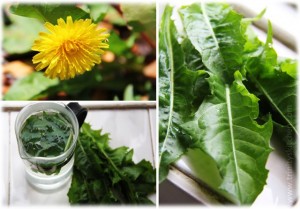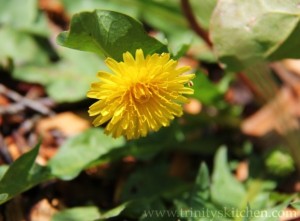Contributing writer for Wake Up World
Dandelions are here to stay. Every springtime in temperate climates they deck fields, meadow, lawns, yards and gardens, with a sunny yellow blanket of bright flower heads. Much to the delight of children, they also throw up tufty seed heads that scatter like elegant fairies with the most gentle breath.
My favourite childhood drink was dandelion & burdock pop, a marriage made in heaven inspired by these much ignored wild plants. I remember eagerly waiting for the delivery man as he brought our weekly order of dandelion & burdock pop and I’ll never forget that refreshing taste as I gulped down a full glass after an afternoon’s work of making mud pies and wild rose perfume. And as for dandelions we used to blow the seed heads and play the game of ‘he loves/he loves me not’ for a bit of superstitious fun.
These days if you mention mention dandelions to most folk you’ll hear a bit of a mutter about how they keep popping up everywhere in the yard and how notoriously difficult they are to control. Dandelions are born survivors, so I like to think that they’re hanging in so that when we all come back to our senses and embrace them for the amazing gifts they bring, they will be right there waiting for us in plentiful supply. It’s often those little down trodden beauties that bring us the most divine gifts of all. I feel deeply thankful for the myriad of golden sun-like flowers that brighten the lawns and meadows in early spring time.
So What is a Dandelion?
Dandelion is a an excellent all rounder and should most certainly feature near the top of any healthy herb collection. They have a thick tap root that makes the perfect coffee substitute, whilst their leaves form a rosette shaped platter of highly nutritious leaves. Bright yellow flowers and tufty white seed heads grow from hollow milky stems, each part having a beneficial role to play for nature, animals and people.
The name dandelion come from the French word dent de lion, which translates to lions teeth. When we take a closer look at their saw shaped leaves, it all makes perfect sense!
How to Eat Dandelions
The flowers are edible both raw and cooked, especially if you take the yellow petals off the bulky head (the head is much more bitter). Dandelion flowers have however achieved particular popularity for their role in helping to create dandelion flower wine.
Leaves can be eaten just like spinach, raw in a salad, sandwiches, tossed in a stir-fry or soup. Most people prefer to use the youngest leaves, since they can get very bitter as they get bigger and mature throughout the season. One of the easiest ways to enjoy the benefits of dandelion is by making an infusion of tea with the leaves (either dried or fresh).
How to Make Dandelion Tea

You can make dandelion tea with either the yellow flower heads or with the leaves. I prefer to use the leaves, although it can look pretty doing it with flowers. The flowers taste more delicate whilst the leaves have an amazing this-is-really-doing-me-good taste!
- Simply infuse the flower heads or a handful of leaves in boiling water in a pot for at least 3 minutes (and for as long as you would like after that). If you have a tea infuser ball you can make it straight in your mug. I would tear about 5 leaves for one mugful.
- Use a strainer to pour a cup of tea and sweeten if desired (or enjoy it as it is if you like a a herby hit, like me).
- You can usually buy dried dandelion leaves from a good health food store or herb shop to be used as a tea infusion.
How to Make Dandelion Coffee from Scratch
The roots are frequently used as a convincing coffee substitute. I am not really a coffee drinker myself, so I can only comment on what I’ve heard from friends who have used this.
- Dig up the roots (which tend to be thicker later in the season).
- Scrub clean (but don’t peel).
- Use a sharp knife to chop them up as small as you can. Spread evenly on a baking tray.
- Roast in the oven either on a low temperature over a long period or higher temperature until they’ve dried out completely (usually when they have turned a light brownish colour).
- When fully roasted, grind in a nut mill, coffee grinder or with a pestle and mortar and use as regular coffee.
- Or alternatively infuse like tea and then strain off the ground root before serving.
It’s worth noting that some people grind – some people don’t. Explore, experiment and just do what you find works best for you. You can also cheat and buy pre-ground dandelion root in good health food stores in the alternative coffee section.
The Many Health Benefits of Dandelions
Dandelions have an excellent reputation as a detoxifier, blood cleanser, stimulant and digestive aid. They act as a liver tonic, removing toxins whilst stimulating the kidneys to ensure that toxins are rapidly eliminated. The fact that bile is cleared out, promotes better digestion and discourages the formation of gallstones. Whilst there haven’t been many clear and concise studies carried out on the health benefits of dandelions (probably because there isn’t any money in things that grow freely!)… traditional cultures including the North Native Americans and the European Celts successfully used these prolific wild plants for a myriad of different health benefits. I’ve outlined a few of the most commonly known uses here.
Diuretic
Dandelion leaves act as a wonderful diuretic. Their high levels of potassium means that any of this essential nutrient flushed out in the urine is easily replaced (potassium depletion is a common side effect of more conventional diuretics). Dandelions cause great relief for fluid retention issues, especially around pre-menstrual-tension, kidney problems or high blood pressure.
Acne and skin problems
Since dandelion acts as a diuretic, detoxifier and anti-oxidant, the juice or tincture can help stimulate and regulate the system to remove the build up of toxins that cause acne. Applying the milky dandelion sap directly can also act against microbial skin infections (but be sure to avoid the eyes). It is believed that the sap found in the hollow stem has good anti-fungal, germicidal and insecticidal properties. This milky white sap can therefore be used to treat skin infections, like eczema and ring worm and especially those diseases caused by microbial and fungal infections. It can also relieve itchiness from bites and stings.
Bladder Issues
Dandelion is a brilliant tonic for the bladder and urinary tract with its ability to cleanse and flush, whilst acting as an anti-microbial to promote a healthy urinary system. It works well on bladder infections like cystitis.
Liver and Gall Bladder
The roots work particularly well to help improve digestion and elimination. This often has benefits for arthritic conditions, gout and skin diseases.
Warts – rubbing the fresh sap on warts every day, over several weeks is said be a painless and effective way of removing them altogether.
Highly Nutritious Superfood
Dandelions offer a potent gift of vitamin A & K, which are excellent at supporting blood health. Vitamin K ensures effective blood clotting, whilst vitamin A regulates blood cell growth. This wild plant also gives a good dose of Vitamin C and calcium to support good bone health. Eye health also benefits greatly from regular consumption of the plant, due to the nutrients lutein and zeaxanthin.
All in all, dandelions make a great addition to your cuisine – a real gift from nature to support general health and wellness as well as specific conditions. Dandelions are generally safe for most people, but if you’re in any doubt or are already taking prescription medications, then please do explore further regarding any specific health conditions that you might have.
For more about foraging wild foods and their benefits, please visit Trinity’s Conscious Kitchen or check out my article “Foraging Guide – with 12 Nutritious Wild Plants That Anyone Can Find”.
With love,
Trinity
Recommended articles by Trinity Bourne:
- 10 Reasons Why We all Should be Eating Ginger – Recipes Included
- Recipe: Green Superfood Smoothie Jam Packed with Health Benefits
- Top Tips for Making Deliciously Healthy Salads
- The Importance of Eating Seeds for a Healthy Diet – Tips, Benefits & Recipes
- Foraging Guide – with 12 Nutritious Wild Plants That Anyone Can Find
- Keeping Slugs & Snails Off Your Veggies – Compassionately
- Chocolate Paradise Coconut Bar Recipe – Vegan, Raw, Absolutely Delicious!
- The Superfood Health Benefits of Celery (with Recipes!)
- Chocolate Covered Coconut Bliss Bars (Vegan, Gluten-Free, No-Bake)
About the author:
Trinity is an experienced, empathic energy worker and the author of ‘Trinity’s Conscious Kitchen’ and ‘Angelicious’, recipe books designed to inspire the soul through conscious vegan, wheat-free and gluten-free cuisine.
22 years ago Trinity had a profound spiritual awakening that interconnected her with the deeper consciousness of life. What followed was a journey of compassion for all sentient beings, and a passion to share conscious eating for the benefit of all. Understanding that the energy of our food directly impacts sentient life on all levels, Trinity founded Trinity’s Conscious Kitchen, a website devoted to inspiring the soul through conscious, plant-based cuisine. She is also the co-founder of Openhand, an organisation dedicated to the conscious evolution of humankind.
For more, visit trinityskitchen.com and follow Trinity’s Kitchen on Pinterest and Facebook!

If you've ever found value in our articles, we'd greatly appreciate your support by purchasing Mindful Meditation Techniques for Kids - A Practical Guide for Adults to Empower Kids with the Gift of Inner Peace and Resilience for Life.
In the spirit of mindfulness, we encourage you to choose the paperback version. Delve into its pages away from screen glare and notifications, allowing yourself to fully immerse in the transformative practices within. The physical book enriches the learning process and serves as a tangible commitment to mindfulness, easily shared among family and friends.
Over the past few years, Wake Up World has faced significant online censorship, impacting our financial ability to stay online. Instead of soliciting donations, we're exploring win-win solutions with our readers to remain financially viable. Moving into book publishing, we hope to secure ongoing funds to continue our mission. With over 8,500 articles published in the past 13 years, we are committed to keeping our content free and accessible to everyone, without resorting to a paywall.









